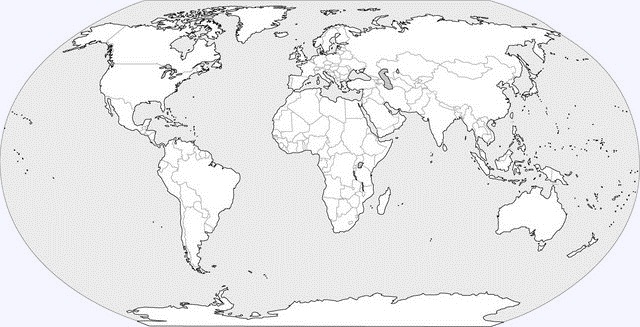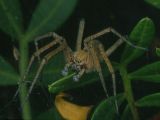|
Nombre común en ingles:
Rock weavers
Nombre común en castellano:
Se desconoce
Familias similares:
Género tipo:
Titanoeca Thorell, 1869
Diagnosis:
Small to médium-sized araneomorph spiders; three
tarsal claws; cribellate; entelegyne; eight eyes; calamistrum long,
uniseriate; endites parallel; male palpal tibia complex, with pro-
and retrolateral apophyses.
Caracteres descriptivos:
Caparazón:
roughly rectangular with anterior margin straight; fovea poorly
defined, a shallow, oval to rectangular depression. Esternón: oval. Ojos: eight;
in two slightly procurved rows; posterior eye row broader than
anterior eye row; posterior eyes with canoe-shaped tapetum. Quelíceros:
fairly long; swollen at base; both margins with two or three teeth;
chilum well developed. Piezas bucales: labium subcircular to
rectangular; endites rectangular, wide, almost parallel. Patas:
three claws; metatarsi each with one long subapical trichobothrium;
tarsi without trichobothria. Palpo femenino:
with claw. Abdomen: short, oval. Hileras:
anterior pair broadened at base with short, dome-shaped second
segment; posterior pair cylindrical with very short second segment;
spigots with concentric ridges. Cribellum: divided; as wide
as base of spinnerets. Calamistrum: uniseriate, long,
extending over almost entire length of metatarsus. Sistema respiratorio:
two booklungs; tracheal spiracle close to spinnerets; tracheae four
simple tubes. Genitalia: entelegyne; epigyne with
longitudinal membranous areas; male palp usually complex; tibia with
pro- and retrolateral apophyses; often with patellar and cymbial
apophyses. Tamaño corporal:
3-12 mm. Color: carapace.
Estatus taxonómico:
Coddington & Levi (1991) placed the Titanoecidae in the Dictynoidea.
Harvey (1995) proposed the Nicodamidae as a possible sister-group.
Coddington et al. (2004) consider them the sister group of
Phyxelididae with which they form the Titanoecoidea. sister to the
RTA-clade.
Distribución: Titanoecidae
are widely distributed in Arctic as well as tropical regions (Indian
Ocean Coast in Africa. not in Australia or New Zealand) but tend to
be more common in the Northern Hemisphere.

Estilo de vida:
Ground-dwelling spiders, making flimsy webs under stones or
cribellate space webs.
Bibliografía:
-
Coddington, J.A. &
Levi, H.W. 1991. Systematics and evolution of spiders (Araneae).
Ann. Rev. Ecol. Syst, 22: 565-592.
-
Cutler, B. 2005c.
Titanoecidae. p. 248 in Ubick, D., Paquin, P., Cushing, P.E. & Roth,
V. (Eds) 2005. The Spiders of North America. An Identification
Manual. American Arachnological Society.
-
Dippenaar-Schoeman, A.S. & Jocqué,
R. 1997. African Spiders: An Identification Manual. Plant Protection
Res. Inst. Handbook, no. 9, Pretoria, 392 pp.
-
Harvey, M.S. 1995.
The systematics of the spiders family Nicodamidae (Araneae:
Amaurobioidea). Invertebr. Taxon. 9: 279-386.
-
Szlep, R. 1966.
Evolution of the web-spinning activities: web-spinning in Titanoeca
albomaculata Luc. (Araneae: Amaurobiidae). Israel J. Zool. 15:
83-88.
2 géneros y 8 especies presentes en la Península Ibérica:
|
| |
- N. albomaculata
(Lucas, 1846) |
| |
- N. sequerai
(Simon, 1892) |
|
| |
- T. hispanica
Wunderlich, 1995 |
| |
- T. monticola
(Simon, 1870) |
| |
- T. nivalis
Simon, 1874 |
| |
- T. praefica
(Simon, 1870) |
| |
- T. quadriguttata
(Hahn, 1833) |
| |
- T. tristis
L. Koch, 1872 |
|
 |